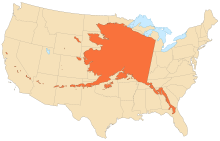This blog is inspired when I heard that one of my closed relative is going to Alaska ( Anchorage and Sitka) for business travel next month. When I was a teenager, the word Alaska I associate as cold, desolate, and wild frontier. As I grow to adulthood, my association with Alaska changed to Eskimo, Dog Race, Bering Strait, Mt McKinley( Denali) National Park and Palin.
My first personal experience in Alaska, was my 3-hour stopover in Anchorage
(via Northwest Airlines) on my way to the East Coast from the
Philippines in 1959 to start my graduate studies in the US. The stopover
was my first day in the US. It was not monumental, but I will never
forget the memories of my first few hours in the US. I was scared
traveling alone but filled with high hopes for my future in the US.
Here's a few facts about the Geography of Alaska from Wikipedia.
Alaska is by far the largest U.S. state by area, comprising more total area than the next three largest states (Texas, California, and Montana) combined. It represents the seventh largest subnational division in the world. It is the third-least populous and the most sparsely populated state, but by far the continent's most populous territory located mostly north of the 60th parallel, with a population of 736,081 as of 2020—more than quadruple the combined populations of Northern Canada and Greenland. Approximately half of Alaska's residents live within the Anchorage metropolitan area. The state capital of Juneau is the second-largest city in the United States by area, comprising more territory than the states of Rhode Island and Delaware. The former capital of Alaska, Sitka, is the largest U.S. city by area.
Alaska is located at the northwest corner of North America, the northernmost and westernmost state in the United States, but also has the most easterly longitude in the United States because the Aleutian Islands extend into the Eastern Hemisphere. Alaska is the only non-contiguous U.S. state on continental North America; about 500 miles (800 km) of British Columbia (Canada) separates Alaska from Washington. It is technically part of the continental U.S., but is sometimes not included in colloquial use; Alaska is not part of the contiguous U.S., often called "the Lower 48". The capital city, Juneau, is situated on the mainland of the North American continent but is not connected by road to the rest of the North American highway system.
The state is bordered by Canada's Yukon and British Columbia to the east (making it the only state to only border a Canadian territory); the Gulf of Alaska and the Pacific Ocean to the south and southwest; the Bering Sea, Bering Strait, and Chukchi Sea to the west; and the Arctic Ocean to the north. Alaska's territorial waters touch Russia's territorial waters in the Bering Strait, as the Russian Big Diomede Island and Alaskan Little Diomede Island are only 3 miles (4.8 km) apart. Alaska has a longer coastline than all the other U.S. states combined.
At 663,268 square miles (1,717,856 km2) in total area, Alaska is by far the largest state in the United States. Alaska is more than twice the size of the second-largest U.S. state (Texas), and it is larger than the next three largest states (Texas, California, and Montana) combined. Alaska is the seventh largest subnational division in the world, and if it was an independent nation would be the 16th largest country in the world, as it is larger than Iran.
With its myriad islands, Alaska has nearly 34,000 miles (55,000 km) of tidal shoreline. The Aleutian Islands chain extends west from the southern tip of the Alaska Peninsula. Many active volcanoes are found in the Aleutians and in coastal regions. Unimak Island, for example, is home to Mount Shishaldin, which is an occasionally smoldering volcano that rises to 10,000 feet (3,000 m) above the North Pacific. The chain of volcanoes extends to Mount Spurr, west of Anchorage on the mainland. Geologists have identified Alaska as part of Wrangellia, a large region consisting of multiple states and Canadian provinces in the Pacific Northwest, which is actively undergoing continent building.
One of the world's largest tides occurs in Turnagain Arm, just south of Anchorage, where tidal differences can be more than 35 feet (10.7 m).
Alaska has more than three million lakes. Marshlands and wetland permafrost cover 188,320 square miles (487,700 km2) (mostly in northern, western and southwest flatlands). Glacier ice covers about 28,957 square miles (75,000 km2) of Alaska. The Bering Glacier is the largest glacier in North America, covering 2,008 square miles (5,200 km2) alone.
Here's are 3 tour videos of the Denali National Park and Preserve-About 240 Miles North of Anchorage
The photography is stunning and mesmerizing worthy of 18 minutes of your time. Enjoy!
Meanwhile enjoy this photo from my collection:
Coconut Lobster and cucumber/tomato salad for lunch, Amoingon, Boac, Marinduque, Philippines, 2004



No comments:
Post a Comment